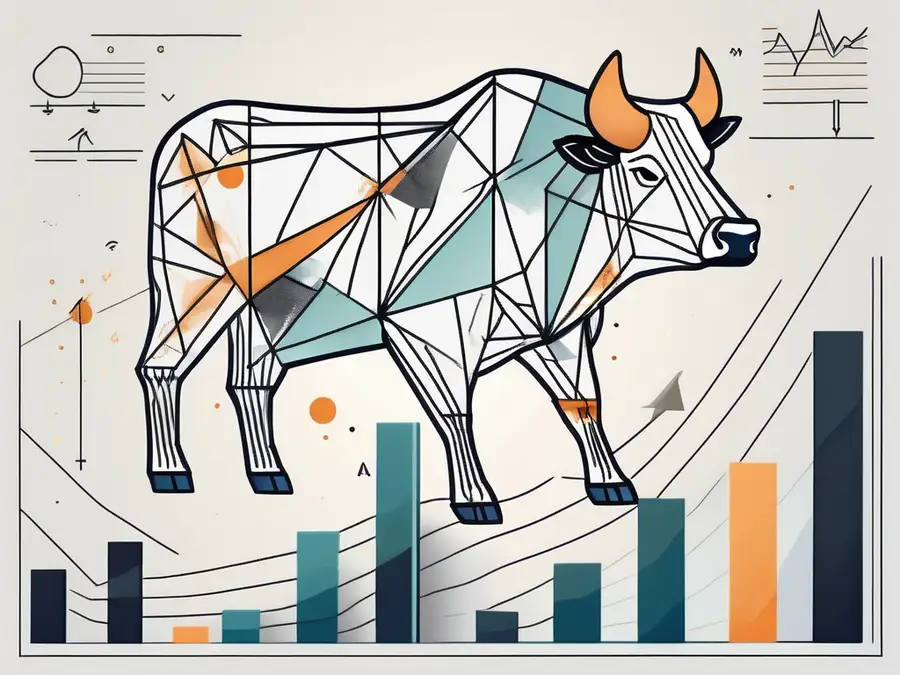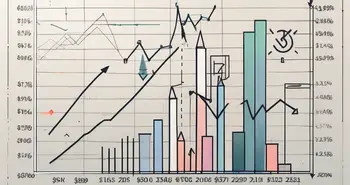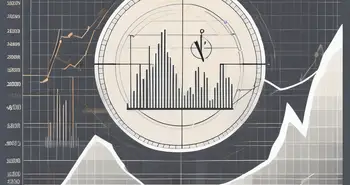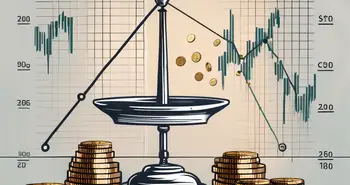Calmar Ratio: How to Evaluate Risk and Maximize Long-Term Returns

The Calmar Ratio is a financial metric used to evaluate the performance of an investment by assessing its risk-adjusted returns. Named after the famed investor and author, Terry W. Calmar, this ratio is particularly useful in capital markets, providing investors with a clearer perspective on the relationship between return and risk.
Traditionally, the Calmar Ratio is calculated by dividing the compound annual growth rate (CAGR) of an investment by its maximum drawdown, which is the largest peak-to-trough decline during a specific timeframe. This calculation allows investors to gauge not only how much they stand to gain but also how much they risk losing, making it a vital tool in effective portfolio management.
The Concept and Calculation of the Calmar Ratio
To fully grasp the concept of the Calmar Ratio, it’s essential to understand its components:
- CAGR: The average annual growth rate of an investment over a specific timeframe.
- Maximum Drawdown: The greatest observed loss from a peak to a trough, providing insight into an investment's risk level.
The formula for calculating the Calmar Ratio is:
Calmar Ratio = CAGR / Maximum Drawdown
This straightforward calculation effectively shows how much return an investor earns for every unit of risk they take, making it easier to identify more favorable investments.
The Importance of the Calmar Ratio in Investment
The significance of the Calmar Ratio lies in its ability to highlight the risk-reward balance in investments. When considering various assets, it’s crucial to not only look at potential returns but also to account for the risk involved. As an investor who has often navigated these waters, I’ve discovered that relying solely on returns can lead to poor investment decisions and unexpected losses. The Calmar Ratio serves as a watchdog against such pitfalls.
By incorporating this ratio into your investment decision-making process, you can better distinguish between assets that offer high returns but come with significant risk from those that provide steadier gains with manageable risk profiles. Furthermore, the Calmar Ratio can be particularly beneficial during volatile market conditions, where understanding the potential for loss becomes as important as recognizing opportunities for growth. Investors can utilize the Calmar Ratio to compare different investment strategies or funds, allowing them to make informed choices that align with their risk tolerance and financial goals.
Moreover, the Calmar Ratio is not just a static measure; it can evolve over time as market conditions change. This adaptability means that investors should regularly revisit and recalculate the ratio for their holdings, ensuring that their portfolio remains aligned with their investment strategy. By doing so, they can proactively manage risk and capitalize on favorable market conditions, ultimately leading to more robust investment outcomes.
The Benefits of Using the Calmar Ratio
Utilizing the Calmar Ratio in your investment strategy brings several advantages that can enhance your overall financial performance. Here are a few key benefits:
Risk Assessment with the Calmar Ratio
One major benefit of the Calmar Ratio is its robust risk assessment capabilities. This ratio helps investors understand the potential downward variability associated with an investment. It enables a deeper analysis of how vulnerable an investment may be to market volatility.
As I often tell my peers, knowing the risk gives you control, while ignoring it can lead to chaos in your portfolio. The Calmar Ratio not only illuminates potential pitfalls but also allows you to make informed decisions tailored to your risk tolerance.
Portfolio Optimization Using the Calmar Ratio
Another significant advantage of utilizing the Calmar Ratio is its role in portfolio optimization. By comparing the Calmar Ratios of different assets, investors can strategically select a mix of investments that optimize returns while controlling for risk.
Picture this: you have a choice between two funds. One has a fantastic return but a high drawdown; the other might be more modest in its returns but has a considerably lower drawdown. Using the Calmar Ratio, you can quantify which option gives you the most return per unit of risk. This ability to balance risk and return is invaluable—a skill I've honed through countless investment decisions.
Limitations of the Calmar Ratio
Despite its benefits, the Calmar Ratio is not a perfect metric and has its limitations. Recognizing these can help you avoid pitfalls in your investment strategy.
Potential Misinterpretations of the Calmar Ratio
One limitation is that the Calmar Ratio can be misinterpreted if investors focus solely on the numbers. A high Calmar Ratio does not automatically indicate a good investment; it may reflect an unusually low drawdown rather than strong overall performance.
In my experience, it’s important to consider the broader market context, as well as other factors influencing an asset's performance before drawing conclusions based solely on the Calmar Ratio. Use it as a piece of the puzzle rather than the whole picture.
Situations Where the Calmar Ratio May Not Be Effective
Furthermore, the Calmar Ratio may not be as effective in certain market conditions, such as periods of extreme volatility or when analyzing investments with shorter time frames. The ratio is best suited for long-term investments, and applying it to short-term scenarios can lead to misleading results.
I've encountered situations where relying solely on the Calmar Ratio during turbulent markets led to hasty decisions. Use it wisely and always in conjunction with additional metrics and thorough analysis.
Comparing the Calmar Ratio with Other Risk-Adjusted Measures
For investors, understanding how the Calmar Ratio stacks up against other risk-adjusted measures can provide more context and clarity during the investment process.
Calmar Ratio vs Sharpe Ratio
The Sharpe Ratio is another popular risk-adjusted measure that quantifies the performance of an investment compared to a risk-free asset, accounting for the investment’s volatility. While both ratios focus on performance relative to risk, the primary difference is the type of risk they measure—maximum drawdown for the Calmar Ratio and standard deviation for the Sharpe Ratio.
In my experience, the two ratios can complement each other well. While the Sharpe Ratio gives insight into a fund’s volatility overall, the Calmar Ratio provides a snapshot of extreme risk, which can be crucial in certain investment strategies.
Calmar Ratio vs Sortino Ratio
The Sortino Ratio is another measure designed to evaluate the return earned in excess of a risk-free rate per unit of downside risk, specifically measuring negative volatility. While the Calmar Ratio considers the largest drawdown, the Sortino Ratio focuses on downside risk only.
In scenarios where an investor is primarily concerned with avoiding losses, the Sortino Ratio might be the preferred measure. However, in my experience, employing both ratios together can better inform your investment decisions by giving a fuller picture of the risk-return balance.
Practical Application of the Calmar Ratio
Applying the Calmar Ratio in real-world investment scenarios can enhance your decision-making and help you carve out a niche in the market.
Using the Calmar Ratio for Fund Selection
When considering different investment funds, the Calmar Ratio can offer a straight path to identifying which funds align with your risk profile and investment goals. By filtering investments through the lens of the Calmar Ratio, you can select those that maximize returns without exposing yourself to unacceptable risks.
I remember a period when I was tasked with selecting mutual funds for investors with varying risk tolerances. Using the Calmar Ratio helped me recommend options that precisely matched their profiles, leading to increased satisfaction and better investment outcomes.
Incorporating the Calmar Ratio into Your Investment Strategy
Finally, integrating the Calmar Ratio into your overall investment strategy can provide a robust framework for financial success. Regularly monitoring your investments’ Calmar Ratio can help inform your ongoing decisions regarding capital allocations and adjustments to your portfolio.
The take-home message here is to remain vigilant and proactive. Keep analyzing and refining your approach by utilizing this valuable metric as part of your comprehensive strategy, allowing you to stay ahead of market trends and optimize your investments effectively.
FAQ
- What is the Calmar Ratio?
The Calmar Ratio is a measure that assesses the risk-adjusted returns of an investment, calculated by dividing its CAGR by its maximum drawdown. - How is the Calmar Ratio calculated?
The ratio is calculated using the formula: Calmar Ratio = CAGR / Maximum Drawdown. - What are the benefits of using the Calmar Ratio?
It helps investors assess risk, optimize portfolios, and make informed decisions regarding their investments. - What are the limitations of the Calmar Ratio?
Potential misinterpretations and its reduced effectiveness during extreme market conditions are key limitations. - How does the Calmar Ratio compare to other ratios like Sharpe and Sortino?
While all measure risk-adjusted returns, they focus on different forms of risk, providing diverse insights for investors.
As you refine your investment strategy with insights from the Calmar Ratio, why not elevate your trading experience with Morpher? Morpher.com is not just another trading platform; it's a revolutionary leap forward, harnessing blockchain technology to offer zero fees, infinite liquidity, and the freedom to invest in a wide array of markets with fractional shares. Whether you're looking to capitalize on market downturns through short selling or amplify your trades with up to 10x leverage, Morpher provides the safety, control, and unique trading opportunities that modern investors crave. Ready to transform your investing journey? Sign Up and Get Your Free Sign Up Bonus today and join the future of trading with Morpher.

Disclaimer: All investments involve risk, and the past performance of a security, industry, sector, market, financial product, trading strategy, or individual’s trading does not guarantee future results or returns. Investors are fully responsible for any investment decisions they make. Such decisions should be based solely on an evaluation of their financial circumstances, investment objectives, risk tolerance, and liquidity needs. This post does not constitute investment advice.

Painless trading for everyone
Hundreds of markets all in one place - Apple, Bitcoin, Gold, Watches, NFTs, Sneakers and so much more.

Painless trading for everyone
Hundreds of markets all in one place - Apple, Bitcoin, Gold, Watches, NFTs, Sneakers and so much more.









